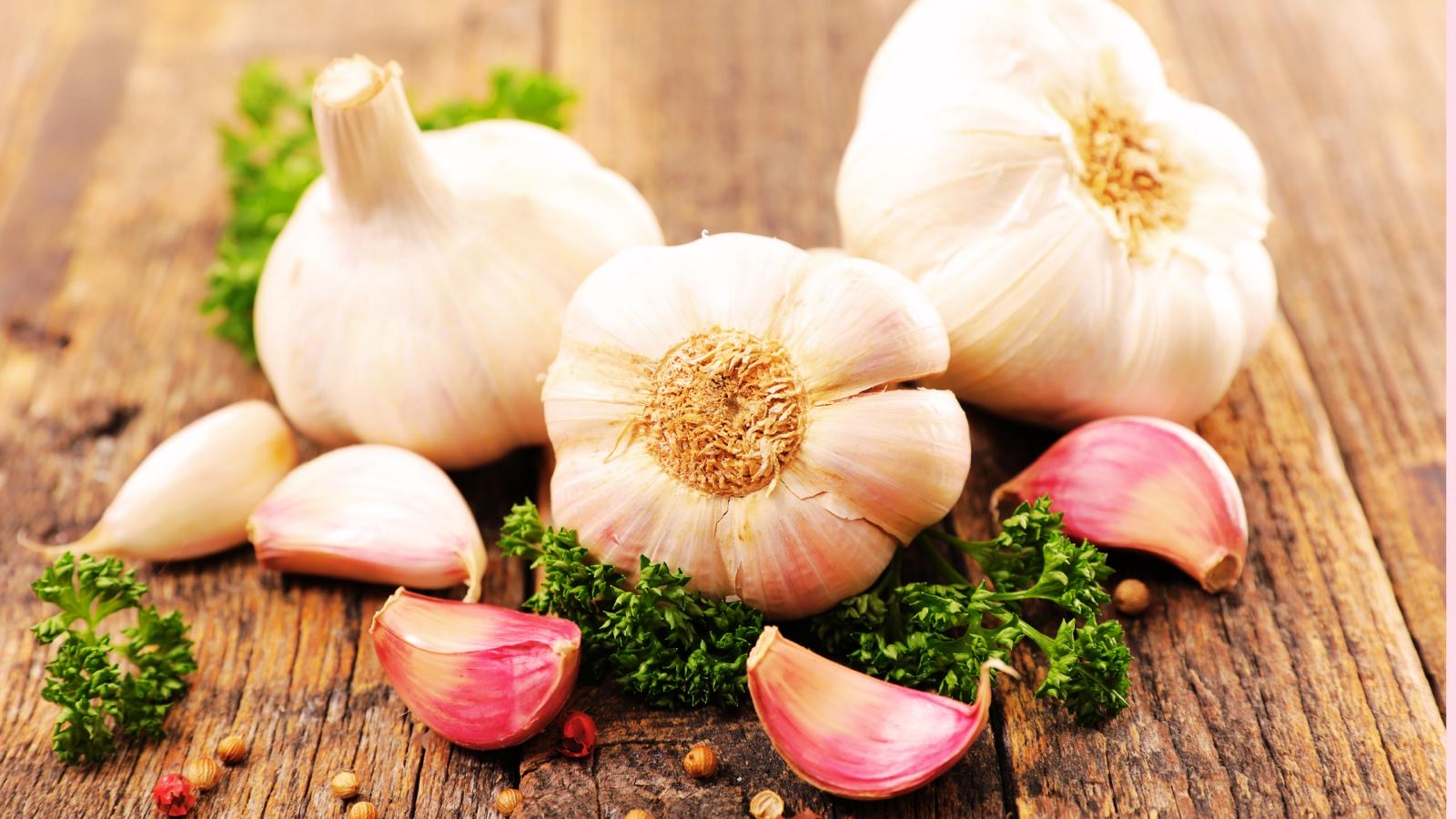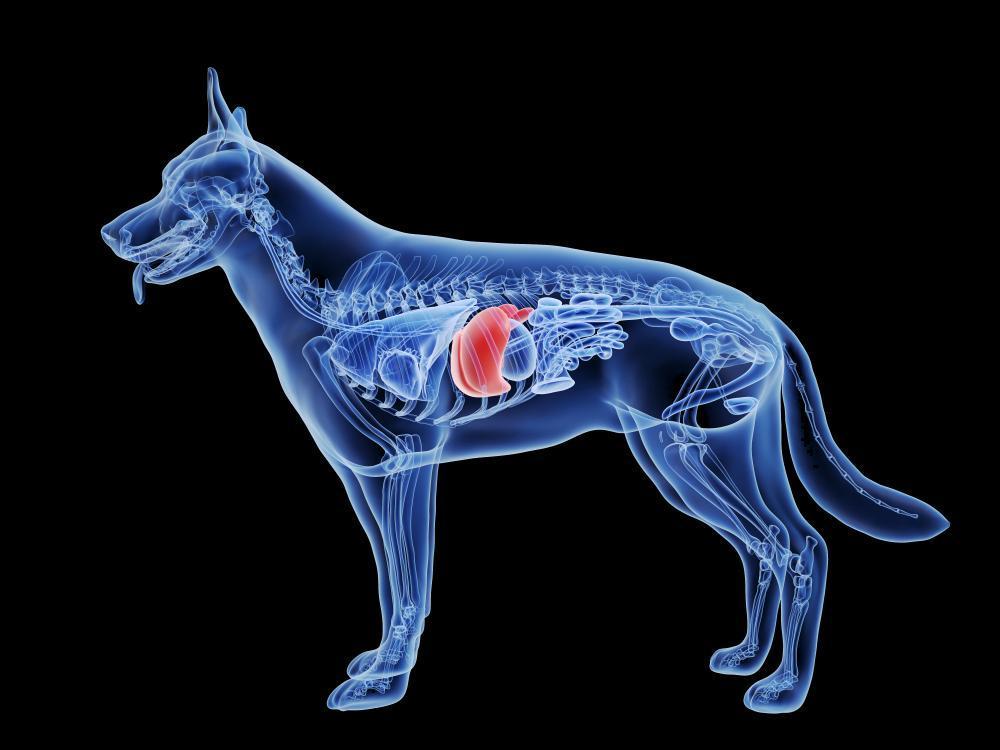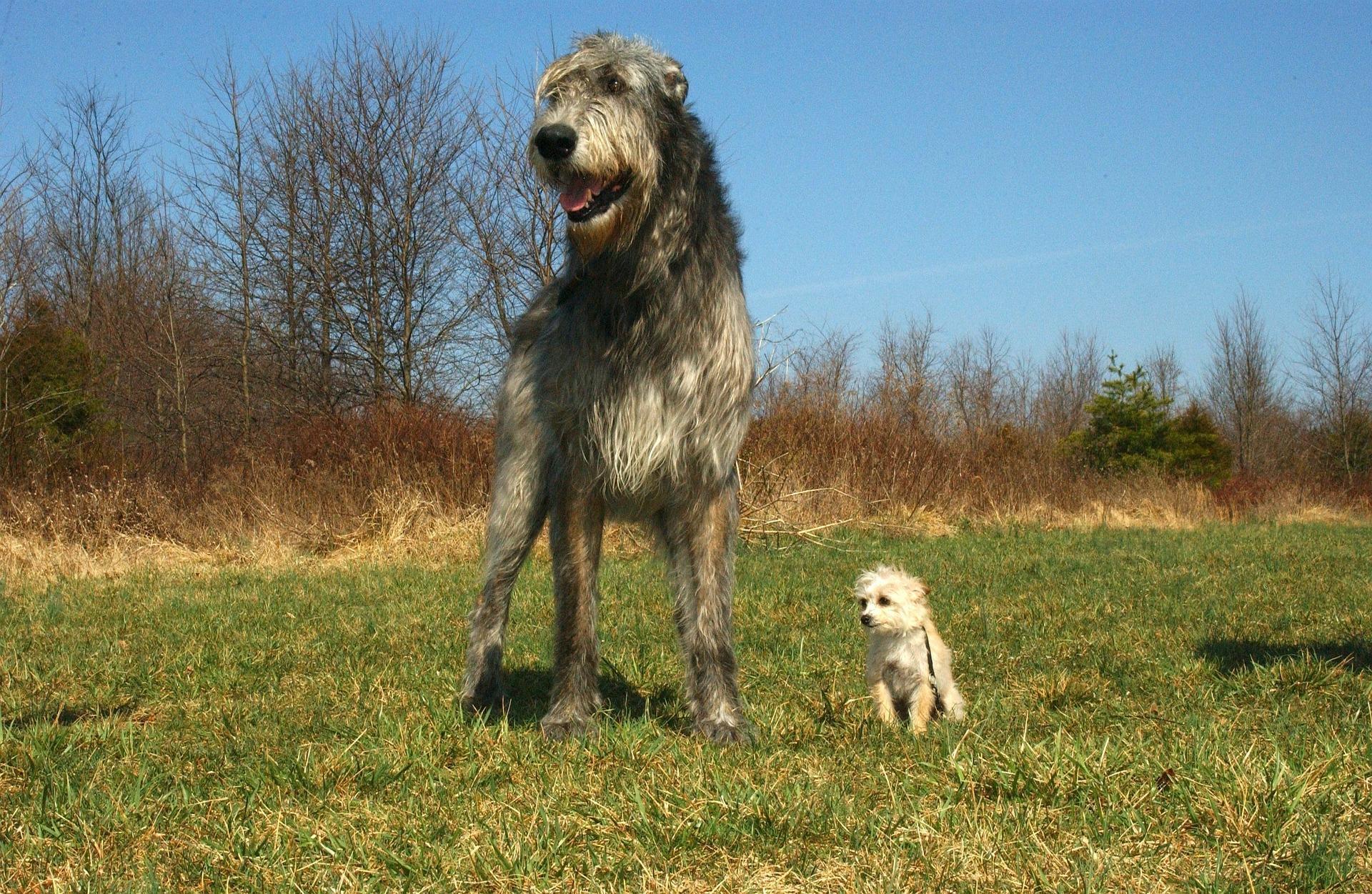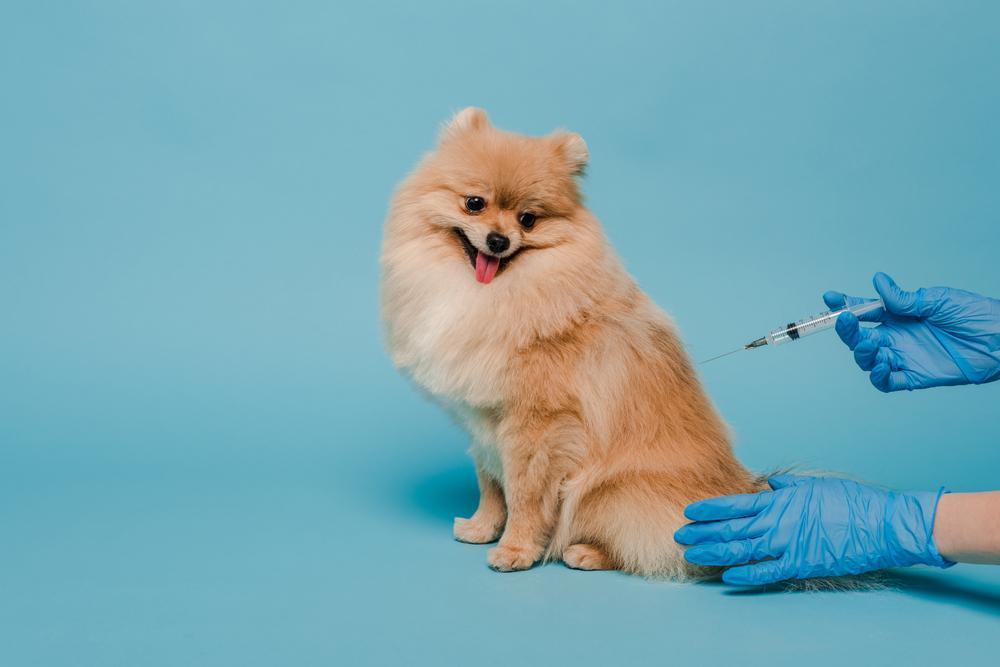-
£19.99

Can My Dog Eat Garlic?
- March 7, 2024
- 10 mins
In the modern dog world, there are so many controversies over various food items, from salmon oil to raw eggs to coconut oil to garlic. Here at My Pet Nutritionist, we like to put owners minds at ease, and help you to evaluate whether it is suitable for your pets, using both scientific and anecdotal evidence based on our professional experience. Salmon oil, raw eggs and coconut oil have all been covered within our blog to date, so now it’s time to have garlic in the spotlight! Let’s discover some myths, and truths about this powerful, often useful ingredient!
Garlic (Latin name: Allium sativum), is the bulb of a flowering plant, and is a potent addition to foods in the human world, for flavour as well as medicine. It’s closest relatives are onions, leeks, shallots and chives. Humans have consumed garlic since the times of Ancient Egypt.
Originating from south and central Asia, and Iran, the vast majority of the world’s garlic production occurs in China.
The chemical make up of garlic gives it it’s many beneficial uses in both the human and dog world, however there are caveats when it comes to garlic and dogs! Allicin, ajoene and polysulfides are among the most powerful sulfur containing compounds, alongside lots of useful enzymes, flavonoids (often useful as antioxidants), and saponins (which have great cancer risk reducing properties, as well as being great for lowering blood fat and blood glucose levels.
Findings Here
Findings Here
The controversy all stems from one specific study on garlic, and it’s affects on dogs. Afterall, it’s relatives onion and leek are very much toxic to our pets, so why should garlic be ok when it contains the same active ingredient, allicin?
As well as allicin, members of the allium family also contain Thiosulfate. Thiosulfate, in large quantities, can cause a severe type of anaemia in cats and dogs, called Heinz Body Anaemia. If we look at onions vs garlic, we can compare the amount of thiosulfate, and therefore calculate the risk of Heinz Body Anaemia. Onions contain large quantities of Thiosulfate, whereas garlic only contains miniscule amounts, which plays very little to no risk in healthy individuals, and studies were began to work out just how much garlic is safe for our pet dogs.
Findings Here
So, moving on to the study. The nutrition world was taken by a storm in 2000 when Dr Osamu Yamamoto released a study called ‘Haemolytic Changes Associated with the Appearance of Eccentrocytes After Intragastric Administration of Garlic Extract to Dogs’.
You can find the study here.
Now, the first point to make, just from looking at the title; garlic ‘extract’ was used. Have you ever baked a cake, using Vanilla Extract? You may notice the extract is extremely concentrated, making it extremely pungent, requiring just a few drips to flavour the entire cake batter! This concept goes for any extract, including that of garlic. The garlic was administered to the dogs in the study in extract form – 1.2mls of this liquid was given to each dog per day for 7 days – likely the equivalent to much more than one would consider giving their dog of anything! More on equivalent amounts shortly.
When looking at the health of the dogs in the study, it’s important to note that there was a death rate of 0% – that’s right, a big fat ZERO! No dogs died in the study, nor were there any physical changes to the dogs. When blood tests were analysed under a microscope, despite the lack of symptoms, there was a case of Heinz Body Anaemia. This was the evidence which caused the scientists to make the rather bold statement, that garlic is unsafe for dogs, sending the pet world into panic! Some of the large pet information databases and websites are still under the assumption that garlic is very much toxic to dogs, warning owners to avoid it.
Pet food manufacturers were forced to remove garlic from their recipes once this information was released, but further studies were needed to ascertain whether fresh garlic would be safe, since the aforementioned study used the ultra concentrated garlic extract. Let’s take a deeper look at exactly how fresh garlic tolerance levels differ to that of concentrated garlic extract!
When converting the amount of garlic extract that would need to be administered to a medium sized dog for adverse reactions to occur, to the equivalent amount of fresh garlic, the dog would need to consume 35 cloves of garlic every day (or 245 cloves per week!) – not something any owner would dream of doing, we are very sure!
Now for the next study by Dr Osamu Yamamoto, titled ‘Acceleration of Superoxide Generation in Polymorphonuclear Leukocytes and Inhibition of Platelet Aggregation by Alk(en)yl Thiosulfates Derived from Onion and Garlic in Dogs and Humans’, published in 2004.
This study can be found here.
In this study, they used a fresher form of garlic to carry out their investigation, which ultimately found that garlic was in fact good for cardiovascular health, and useful for a strong immune system.
Despite these newer findings, the organisations warning pet owners to avoid garlic, as we mentioned above, still advocate for this view, which leaves the pet industry in turmoil, and makes people wary of giving garlic. News spreads fast in the pet industry, and once something is widely believed, it can be extremely difficult to change the opinion of the general pet owning population, who still trust and believe these outdated resources.
A third, and final study by Dr Osamu Yamamoto, further confirming that garlic is safe in the correct dosages was published in 2018, called ‘Safety and Efficacy of Aged Garlic Extract in Dogs: Upregulation of the Nuclear Factor Erythroid 2-Related Factor 2 (NrF2) Signalling Pathway and NrF2-Regulated Phase II Antioxidant Enzymes’, which not only confirmed that even garlic extract is safe in small doses, but also that garlic is very much beneficial, and effective for use as a therapeutic agent in our pet dogs!
This study can be found here.
Let’s discuss the benefits of feeding garlic to out dogs!
Findings Here
We can also go on to looking at flea and tick prevention. There are vast amounts of studies containing evidence that flea and tick prevention by garlic is very much doable in humans. From our own evidence after observing our extensive client base, we can confirm this is also a generally effective way to prevent ticks and fleas in dogs too! More and more studies are coming out to confirm our anecdotal evidence too, regarding garlic as part of the prevention for fleas, ticks and other endoparasites.
Findings Here
Findings Here
Findings Here
These properties make it a great option for part of a cancer treatment and prevention regime, as free radicals are targeted and destroyed, which leads to less oxidative stress – something that commonly leads to cancer.
Garlic also has tumour inhibition properties, so is something worth discussing with a homeopathic veterinarian if your dog is diagnosed with cancer.
Findings Here
Findings Here
Findings Here
When looking at the blood of those consuming garlic, blood clots are also prevented, which again aids heart health and general longevity. It should not be used in those who have blood clotting issues though, unless under the guidance of a veterinarian.
Findings Here
Thirdly, the consumption of garlic aids the reduction of cholesterol. Those with high cholesterol are at a much higher risk of heart disease than those with lower cholesterol. In fact, in the vast majority of studies (of which there are a lot!) there is an enormous difference in cholesterol levels between those consuming garlic and those not consuming garlic.
Findings Here
Findings Here
The reduction of blood glucose is also apparent in those who regularly consume garlic, giving yet another haemolytic and cardiovascular benefit, especially for those who suffer from diabetes mellitus.
Findings Here
Findings Here
Findings Here
Findings Here
Findings Here
Findings Here
Findings Here
Findings Here
Findings Here
We often get asked if you can use ‘lazy garlic’ – you know, the jar of pre-chopped garlic. It may be super easy to use when we are cooking – who doesn’t love a shortcut in the kitchen?! However this is not something we would recommend using for dogs! The concentration of the garlic in the jar is largely unknown, and as it has been chopped and preserved for an unknown amount of time, meaning the active ingredient is likely useless.
As with anything, the dosage of garlic is the important part to get right! The recommended dosage is around ½-1 clove per 10kg bodyweight, 3-4 times per week.
Preparation of garlic is key to it’s efficacy in dogs! The enzyme called Allinase is the active ingredient in garlic, and it is released when the garlic if crushed or chopped. Once crushed or chopped, it takes around 15 minutes for the allicin to develop to it’s most useful state.
To err on the side of caution, we also recommend avoiding the use of garlic for puppies under 6 months of age so as not to risk thiosulfate poisoning in a developing dog.
Those with sensitive dogs, should start off using miniscule amounts, and gradually building up to the full dosage as some dogs, like humans, may be slightly intolerant to garlic due to the content of Sulphorane. We also find, in practice, that dogs suffering with IBD don’t tolerate garlic very well, so it may be wise to avoid it’s use for these individuals.
We hope this blog post has helped you make an informed decision as to whether or not you choose to add fresh garlic into your pets’ diet, and perhaps planted a seed as to it’s benefits for you to give further thought. If you wish to chat to one of our team to improve the diet and lifestyle of your currently healthy dog, our Optimise package for dogs will be suitable for you!
Team MPN x
What Is Garlic?
This may seem a bit of an obvious section to many, but you may learn something new too!Garlic (Latin name: Allium sativum), is the bulb of a flowering plant, and is a potent addition to foods in the human world, for flavour as well as medicine. It’s closest relatives are onions, leeks, shallots and chives. Humans have consumed garlic since the times of Ancient Egypt.
Originating from south and central Asia, and Iran, the vast majority of the world’s garlic production occurs in China.
The chemical make up of garlic gives it it’s many beneficial uses in both the human and dog world, however there are caveats when it comes to garlic and dogs! Allicin, ajoene and polysulfides are among the most powerful sulfur containing compounds, alongside lots of useful enzymes, flavonoids (often useful as antioxidants), and saponins (which have great cancer risk reducing properties, as well as being great for lowering blood fat and blood glucose levels.
Findings Here
Findings Here
The Controversy Around Garlic
As dog owners, we only want the best for our precious pooches! And that’s where the confusion sets in – safe? Unsafe? My vet said it’s toxic! Someone on an online dog forum said it’s toxic, but another said its ok? The stigma around garlic really is huge! Some professionals will advise against it through no fault of their own – it’s often simply what is taught to them during their education.The controversy all stems from one specific study on garlic, and it’s affects on dogs. Afterall, it’s relatives onion and leek are very much toxic to our pets, so why should garlic be ok when it contains the same active ingredient, allicin?
As well as allicin, members of the allium family also contain Thiosulfate. Thiosulfate, in large quantities, can cause a severe type of anaemia in cats and dogs, called Heinz Body Anaemia. If we look at onions vs garlic, we can compare the amount of thiosulfate, and therefore calculate the risk of Heinz Body Anaemia. Onions contain large quantities of Thiosulfate, whereas garlic only contains miniscule amounts, which plays very little to no risk in healthy individuals, and studies were began to work out just how much garlic is safe for our pet dogs.
Findings Here
So, moving on to the study. The nutrition world was taken by a storm in 2000 when Dr Osamu Yamamoto released a study called ‘Haemolytic Changes Associated with the Appearance of Eccentrocytes After Intragastric Administration of Garlic Extract to Dogs’.
You can find the study here.
Now, the first point to make, just from looking at the title; garlic ‘extract’ was used. Have you ever baked a cake, using Vanilla Extract? You may notice the extract is extremely concentrated, making it extremely pungent, requiring just a few drips to flavour the entire cake batter! This concept goes for any extract, including that of garlic. The garlic was administered to the dogs in the study in extract form – 1.2mls of this liquid was given to each dog per day for 7 days – likely the equivalent to much more than one would consider giving their dog of anything! More on equivalent amounts shortly.
When looking at the health of the dogs in the study, it’s important to note that there was a death rate of 0% – that’s right, a big fat ZERO! No dogs died in the study, nor were there any physical changes to the dogs. When blood tests were analysed under a microscope, despite the lack of symptoms, there was a case of Heinz Body Anaemia. This was the evidence which caused the scientists to make the rather bold statement, that garlic is unsafe for dogs, sending the pet world into panic! Some of the large pet information databases and websites are still under the assumption that garlic is very much toxic to dogs, warning owners to avoid it.
Pet food manufacturers were forced to remove garlic from their recipes once this information was released, but further studies were needed to ascertain whether fresh garlic would be safe, since the aforementioned study used the ultra concentrated garlic extract. Let’s take a deeper look at exactly how fresh garlic tolerance levels differ to that of concentrated garlic extract!
What Science Has to Say About It
As with many preliminary scientific studies, mass panic had set in, opening up opportunities to research the tolerance level of fresh garlic in dogs, after all in unsuitable quantities, anything can be classed as toxic – even water, and we all know water is incredibly important for all living things!When converting the amount of garlic extract that would need to be administered to a medium sized dog for adverse reactions to occur, to the equivalent amount of fresh garlic, the dog would need to consume 35 cloves of garlic every day (or 245 cloves per week!) – not something any owner would dream of doing, we are very sure!
Now for the next study by Dr Osamu Yamamoto, titled ‘Acceleration of Superoxide Generation in Polymorphonuclear Leukocytes and Inhibition of Platelet Aggregation by Alk(en)yl Thiosulfates Derived from Onion and Garlic in Dogs and Humans’, published in 2004.
This study can be found here.
In this study, they used a fresher form of garlic to carry out their investigation, which ultimately found that garlic was in fact good for cardiovascular health, and useful for a strong immune system.
Despite these newer findings, the organisations warning pet owners to avoid garlic, as we mentioned above, still advocate for this view, which leaves the pet industry in turmoil, and makes people wary of giving garlic. News spreads fast in the pet industry, and once something is widely believed, it can be extremely difficult to change the opinion of the general pet owning population, who still trust and believe these outdated resources.
A third, and final study by Dr Osamu Yamamoto, further confirming that garlic is safe in the correct dosages was published in 2018, called ‘Safety and Efficacy of Aged Garlic Extract in Dogs: Upregulation of the Nuclear Factor Erythroid 2-Related Factor 2 (NrF2) Signalling Pathway and NrF2-Regulated Phase II Antioxidant Enzymes’, which not only confirmed that even garlic extract is safe in small doses, but also that garlic is very much beneficial, and effective for use as a therapeutic agent in our pet dogs!
This study can be found here.
Let’s discuss the benefits of feeding garlic to out dogs!
Beneficial Uses of Garlic
There are many benefits to using garlic for our dogs! Be sure to check out the caveats listed toward the end of this blog post before considering garlic.Pest Prevention
Fresh Garlic has anthelmintic properties – meaning it is able to aid the body in the removal of intestinal parasites. There are various studies on a variety of different species from dogs to cats to pigs and rats. While garlic may not be hugely effective on mature worms, it is suggested that it is very useful on worm eggs, and juvenile worms.Findings Here
We can also go on to looking at flea and tick prevention. There are vast amounts of studies containing evidence that flea and tick prevention by garlic is very much doable in humans. From our own evidence after observing our extensive client base, we can confirm this is also a generally effective way to prevent ticks and fleas in dogs too! More and more studies are coming out to confirm our anecdotal evidence too, regarding garlic as part of the prevention for fleas, ticks and other endoparasites.
Findings Here
Findings Here
Findings Here
Antioxidants
Fresh garlic is a fantastic source of flavonoids – naturally occurring chemical compounds which have great antioxidant properties.These properties make it a great option for part of a cancer treatment and prevention regime, as free radicals are targeted and destroyed, which leads to less oxidative stress – something that commonly leads to cancer.
Garlic also has tumour inhibition properties, so is something worth discussing with a homeopathic veterinarian if your dog is diagnosed with cancer.
Findings Here
Findings Here
Cardiovascular and Haemolytic Health
As the subheading suggests, garlic benefits the heart and blood of mammals. It is a vasodilator – this means it enables the blood vessels to widen, ultimately allowing for improved circulation to and from the heart, and around the rest of the body.Findings Here
When looking at the blood of those consuming garlic, blood clots are also prevented, which again aids heart health and general longevity. It should not be used in those who have blood clotting issues though, unless under the guidance of a veterinarian.
Findings Here
Thirdly, the consumption of garlic aids the reduction of cholesterol. Those with high cholesterol are at a much higher risk of heart disease than those with lower cholesterol. In fact, in the vast majority of studies (of which there are a lot!) there is an enormous difference in cholesterol levels between those consuming garlic and those not consuming garlic.
Findings Here
Findings Here
The reduction of blood glucose is also apparent in those who regularly consume garlic, giving yet another haemolytic and cardiovascular benefit, especially for those who suffer from diabetes mellitus.
Findings Here
Gut Health
As regular readers of our blog will be aware, gut health is key to health and longevity, and avoidance of many diseases. Studies suggest that garlic may help to detoxify the gut, and also aid the healthy formation and population of the gut microbiome. As around 80% of the immune system lays in the gut, a healthy, well populated gut microbiome is essential to immediate health, and longevity.Findings Here
Findings Here
Immune Health
Moving onto another immune system related benefit to feeding fresh garlic, looking more specifically at the lymphatic system. The lymphatic system is a major part of the immune system, and plays the role of protection from infection. It is a complex network of tubes found throughout the body, and includes the lymph nodes. White blood cells are found in the lymphatic system – these are what fight infection. Garlic is known to improve and stimulate the function of the lymphatic system, which ultimately aids healing and infection fighting both internally and externally.Findings Here
Liver Health
Another therapeutic effect of feeding fresh garlic involves the liver. The liver’s role is to filter blood after it passes through the intestinal tract, and remove toxins, break down nutrients, and metabolize any drugs in the body. Garlic aids the breakdown of nutrients throughout the digestive tract, leaving the liver to deal more efficiently with toxins and drug metabolism.Findings Here
Findings Here
Ear Infection Help
The final benefit of garlic we will discuss, is it’s wonderful natural antibiotic properties. This can be particularly useful in dogs with ear infections. Not only does it have oral antibiotic properties, but it also has topical antibiotic properties too! Using garlic oil drops as a means to combat ear infections may be something you wish to discuss with your veterinarian!Findings Here
Findings Here
Findings Here
Using Garlic
When deciding which garlic based product to use, we advocate, as always, to use fresh garlic! Using dried supplemental versions may not be as beneficial, simply because human versions can be too potent, and dog specific supplements can be too weak as they are largely unregulated.We often get asked if you can use ‘lazy garlic’ – you know, the jar of pre-chopped garlic. It may be super easy to use when we are cooking – who doesn’t love a shortcut in the kitchen?! However this is not something we would recommend using for dogs! The concentration of the garlic in the jar is largely unknown, and as it has been chopped and preserved for an unknown amount of time, meaning the active ingredient is likely useless.
As with anything, the dosage of garlic is the important part to get right! The recommended dosage is around ½-1 clove per 10kg bodyweight, 3-4 times per week.
Preparation of garlic is key to it’s efficacy in dogs! The enzyme called Allinase is the active ingredient in garlic, and it is released when the garlic if crushed or chopped. Once crushed or chopped, it takes around 15 minutes for the allicin to develop to it’s most useful state.
Crush or chop, leave for 15 minutes, and serve – simple!
When NOT to Use Garlic
As we mentioned near the start of this blog post, there are some caveats to using garlic safely in our pet dogs! While garlic is safe in the correct dosages for the vast majority of breeds, there are some breeds that are thought to be more susceptible to thiosulfate poisoning – namely your Japanese breeds, including these popular breeds:- Japanese Akita Inus
- American Akitas
- Shiba Ines
- Japanese Spitz
- Japanese Chins
- Korean Jindos
To err on the side of caution, we also recommend avoiding the use of garlic for puppies under 6 months of age so as not to risk thiosulfate poisoning in a developing dog.
Those with sensitive dogs, should start off using miniscule amounts, and gradually building up to the full dosage as some dogs, like humans, may be slightly intolerant to garlic due to the content of Sulphorane. We also find, in practice, that dogs suffering with IBD don’t tolerate garlic very well, so it may be wise to avoid it’s use for these individuals.
We hope this blog post has helped you make an informed decision as to whether or not you choose to add fresh garlic into your pets’ diet, and perhaps planted a seed as to it’s benefits for you to give further thought. If you wish to chat to one of our team to improve the diet and lifestyle of your currently healthy dog, our Optimise package for dogs will be suitable for you!
Team MPN x
Customer Reviews
Related articles

Dietary NeedsGeneral HealthGut HealthHeart HealthLiver Health
Why Cooked Food is Best for Your Pet’s Kidney and Liver Disease
May 30 2024
•
6 mins 55 secs

Dietary NeedsGeneral HealthGut HealthHeart HealthLiver Health
Can My Dog Eat Garlic?
Mar 07 2024
•
10 mins

Dietary NeedsGeneral HealthGut HealthHeart HealthLiver Health
How to Support Liver Disease Naturally
Dec 21 2023
•
8 mins 30 secs

Dietary NeedsGeneral HealthGut HealthHeart HealthLiver Health
Can Diet Cause Raised Liver Enzymes?
Nov 16 2023
•
6 mins 20 secs

Dietary NeedsGeneral HealthGut HealthHeart HealthLiver Health
How to Help My Yeasty Dog
Oct 26 2023
•
10 mins 30 secs

Dietary NeedsGeneral HealthGut HealthHeart HealthLiver Health
Why Does My Dog Urinate So Much?
Dec 08 2022
•
5 mins 30 secs

Dietary NeedsGeneral HealthGut HealthHeart HealthLiver Health
How To Support My Dog’s Liver Shunt
Jun 20 2022
•
4 mins 46 secs

Dietary NeedsGeneral HealthGut HealthHeart HealthLiver Health
Does the Breed of My Dog Influence their Test Results?
May 19 2022
•
2 mins 56 secs

Dietary NeedsGeneral HealthGut HealthHeart HealthLiver Health
What Could Cause Elevated Liver Enzymes in My Dog?
May 17 2022
•
6 mins 4 secs

Dietary NeedsGeneral HealthGut HealthHeart HealthLiver Health
4 Superfoods for Liver Health in Dogs
Jan 19 2022
•
4 mins 15 secs

Dietary NeedsGeneral HealthGut HealthHeart HealthLiver Health
A Brief Guide to Liver Function in Pets
Jan 17 2022
•
4 mins 16 secs

Dietary NeedsGeneral HealthGut HealthHeart HealthLiver Health
Why Does My Dog Need Minerals – Part Two
Sep 23 2021
•
12 min read

Dietary NeedsGeneral HealthGut HealthHeart HealthLiver Health
Why Does My Dog Need Minerals – Part One
Sep 22 2021
•
7 min read

Dietary NeedsGeneral HealthGut HealthHeart HealthLiver Health
Keeping Your Senior Dog Healthy
Aug 17 2021
•
5 min read

Dietary NeedsGeneral HealthGut HealthHeart HealthLiver Health
Bacterial Overgrowth – More Common Than You Think
Aug 04 2021
•
6 min read

Dietary NeedsGeneral HealthGut HealthHeart HealthLiver Health
The Lowdown on Liver Shunts in Dogs
Jun 28 2021
•
6 min read

Dietary NeedsGeneral HealthGut HealthHeart HealthLiver Health
Why Is My Dog Regurgitating?
Jun 07 2021
•
5 min read

Dietary NeedsGeneral HealthGut HealthHeart HealthLiver Health
Glyphosate and My Dog
Jun 07 2021
•
5 min read

Dietary NeedsGeneral HealthGut HealthHeart HealthLiver Health
Foods to Feed in Liver Disease
May 10 2021
•
7 min read

Dietary NeedsGeneral HealthGut HealthHeart HealthLiver Health
Does My Pet Need to Detox
Apr 15 2021
•
8 min read

Dietary NeedsGeneral HealthGut HealthHeart HealthLiver Health
Facts on the Leptosporosis Vaccine
Feb 01 2021
•
6 min read

Dietary NeedsGeneral HealthGut HealthHeart HealthLiver Health
Why Is My Dog A Fussy Eater?
Jan 18 2021
•
10 min read

Dietary NeedsGeneral HealthGut HealthHeart HealthLiver Health
Why is My Dog Losing His Hair?
Jan 04 2021
•
7 min read

Dietary NeedsGeneral HealthGut HealthHeart HealthLiver Health
5 Reasons Your Dog May Have Bad Breath
Nov 30 2020
•
7 min read

Dietary NeedsGeneral HealthGut HealthHeart HealthLiver Health
Why Zinc is Important for your Dog
Sep 10 2020
•
8 min read

Dietary NeedsGeneral HealthGut HealthHeart HealthLiver Health
7 Wonderful Herbs for Dogs
Jul 06 2020
•
9 min read

Dietary NeedsGeneral HealthGut HealthHeart HealthLiver Health
Does My Dog Have a Vitamin Deficiency?
May 04 2020
•
15 min read

Dietary NeedsGeneral HealthGut HealthHeart HealthLiver Health
Ultimate Natural Guide for Pets: Liver Disease
Apr 30 2020
•
15 min

Dietary NeedsGeneral HealthGut HealthHeart HealthLiver Health
7 Top Reasons to use Clay in your Dog’s Diet Regime
Feb 20 2020
•
5 min read

Dietary NeedsGeneral HealthGut HealthHeart HealthLiver Health
Itching has become such an epidemic
Feb 18 2020
•
6 min read
✕





